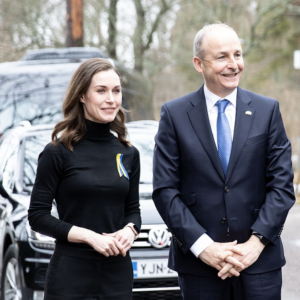Shock waves of the continuing Ukraine conflict are reaching the previously improbable victim of the Republic of Ireland, prompting this neutral nation to arrange closer ties with NATO.
Premier (Taoiseach) Micheal Martin has acknowledged Russia is using cyberattacks far beyond the regional war zone so that even distant Ireland on the continent’s Atlantic flank is vulnerable to electronic sabotage.
Indeed, highly so. The government has repeatedly warned institutions and businesses that they must improve their precautions against Russian cyberattacks and disinformation efforts.
“The threat level has increased,” the defense minister, Simon Coveney, recently assessed. In advocating a considerable boost to military spending, Coveney said. “We need to know what is going on in Irish maritime and airspace.”
Historically Ireland has always been a backwater in the continent’s military infrastructure and security. It was a non-combatant during World War II. Apart from participating in peacekeeping efforts, it has been more or less off-stage, although it is the host of a U.N. training school.
Now, however, a rethink is underway. In part, this is prompted by lurid Russian threats against Britain that would affect tranquil Ireland. Moscow is thought to have caused the recent massive cyberattack that disrupted the Irish health service. The Irish government is keen to stress such events is not to reopen old arguments over whether the country should ditch neutrality in favor of alliance membership, though in some quarters it almost certainly will. Still, it remains the case that “as between a fireman and a fire there’s no neutrality.”
The issue is how President Biden’s favorite European nation can get closer to NATO (and co-operate with it) yet not join up. These days distance from war zones offers little protection.
At this point, a weird and certainly little-known bureaucratic beast heaves into partial view.
It is the “European Centre of Excellence for Countering Hybrid Threats” with headquarters in Helsinki, Finland. It is a sort of hybrid in its own right in that it is uniquely sponsored jointly by NATO and the European Union and works for both groupings.
This “Push-Me, Pull-You” body was founded only five years ago with nine members when it dawned that the distinction between war and peace was being blurred by cyber technology.
The center’s network, promoting research and exercises against every brand of hostility up to — but not including — traditional warfare now has 31 members in the Euro-Atlantic community sharing 1,500 experts from government, private businesses and universities.
The Irish snubbed an original invitation to join but now have second thoughts. The government is preparing to join what we’re bidden to call the “Hybrid CoE.”
Irish membership will add to Vladimir Putin’s collection of unintended consequences in his war against Ukraine. More significant still is that, after many decades of ostentatious neutrality, Sweden and Finland are poised to join NATO’s ranks, making the whole of the Baltic Sea on Russia’s doorstep an allies’ enclave.
In central Europe, just the two Alpine republics, Switzerland and Austria, remain outside NATO as both are bound by constitutions not to do so. Ireland is different: it is a matter only of public opinion.
As Martin says: “I’ve consistently said we need to reflect on military non-alignment in Ireland. We are not politically neutral, and Ireland will be part of Europe’s defense process.”
Participating in the electronic conflict between East and West will not, therefore, violate Ireland’s military non-alignment, but it will be better able to defend itself in the stealthy turmoil that is cyberspace.

